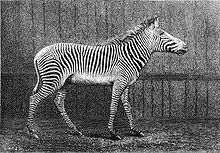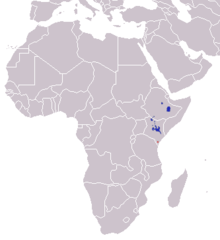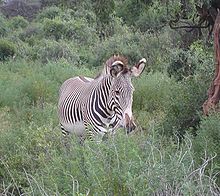The Grévy's zebra lives in semi-arid grasslands where it feeds on grasses, legumes, and browse; it can survive up to five days without water. It differs from the other zebra species in that it does not live in harems and has few long-lasting social bonds. Male territoriality and mother–foal relationships form the basis of the social system of the Grévy's zebra. This zebra is considered to be endangered. Its population has declined from 15,000 to 3,000 since the 1970s. However, as of 2008 the population is stable.

Taxonomy and naming
The Grévy's zebra was first described by French naturalist Émile Oustalet in 1882. He named it after Jules Grévy, then president of France, who, in the 1880s, was given one by the government of Abyssinia. Traditionally, this species was classified in the subgenus Dolichohippus with plains zebra and mountain zebra in Hippotigris. Fossils of zebra-like equids have been found throughout Africa and Asia in the Pliocene and Pleistocene deposits.[3] Notable examples include E. sanmeniensis from China, E. cautleyi from India, E. valeriani from central Asia and E. oldowayensis from East Africa.[3] The latter, in particular is very similar to the Grévy's zebra and may have been its ancestor.[3] The modern Grévy's zebra arose in the early Pleistocene.[3] Zebras appear to be a monophyletic linage[4][5][6] and recent (2013) phylogenies have placed Grevy's zebra in a sister taxon with the plains zebra.[4] In areas where Grévy's zebras are sympatric with plains zebras, the two may gather in same herds[7] and fertile hybrids do occur.[8]Description
As with all zebra species, the Grevy's zebra's pelage has a black and white striping pattern. The stripes are narrow and close-set, being broader on the neck, and they extend to the hooves.[11] The belly and the area around the base of the tail lack stripes which is unique to the Grevy's zebra. Foals are born with brown and white striping, with the brown stripes darkening as they grow older.[11] Embryological evidence has shown that the zebra's background color is dark and the white is an addition.[3] The stripes of the zebra may serve to make it look bigger than it actually is or disrupt its outline. It appears that a stationary zebra can be inconspicuous at night or in shade.[11] Experiments have suggested that the stripes polarize light in such a way that it discourages biting horse-flies in a manner not shown with other coat patterns.[12] Other studies suggest that when moving the stripes may confuse observers, such as mammalian predators and biting insects, via two visual illusions, the wagon wheel effect, where the perceived motion is inverted, and the barber pole illusion, where the perceived motion is in a wrong direction.[13]
Ecology and behavior
The Grévy’s zebra largely inhabits northern Kenya, with some isolated populations in Ethiopia.[10]:147[11] It was extirpated from Somalia and Djibouti and its status in South Sudan is uncertain.[2] It lives in Acacia-Commiphora bushlands and barren plains.[7] Ecologically, this species is intermediate between the arid-living African wild ass and the water-dependent plains zebra.[10]:147[7] Lactating females and non-territorial males use areas with green, short grass and medium, dense bush more often than non-lactating females and territorial males.[14]Grévy's zebras rely on grasses, legumes, and browse for nutrition.[11] They commonly browse when grasses are not plentiful.[7][15] Their hindgut fermentation digestive system allows them to subsist on diets of lower nutritional quality than that necessary for ruminant herbivores. Grevy's zebras can survive up to five days without water, but will drink daily when it is plentiful.[16] They often migrate to better watered highlands during the dry season.[7] Females require significantly more water when they are lactating.[17] During droughts, the zebras will dig water holes and defend them.[7] Grévy's zebras are preyed on by lions, hyenas, wild dogs, cheetahs and leopards.[11] In addition, they are susceptible to various gastro-intestinal parasites, notably of the Trichostrongylus genus.[18]
Adult males mostly live in territories during the wet seasons but some may stay in them year round if there's enough water left.[7] Stallions that are unable to establish territories are free-ranging[10]:151 and are known as bachelors. Females, young and non-territorial males wander through large home ranges. The females will wander from territory to territory preferring the ones with the highest-quality food and water sources.[19] Up to nine males may compete for a female outside of a territory.[11]
Territorial stallions will tolerate other stallions who wander in their territory, however when an estrous female is present the territorial stallion keeps other males at bay.[7][10]:151 Non-territorial males may avoid territorial ones because of harassment.[14] When females are not around, a territorial stallion will seek the company of other stallions. The stallion shows his dominance with an arched neck and a high-stepping gait and the least dominant stallions submit by extending their tail, lowering their heads and nuzzling their superior's chest or groin.[10]:151 The call of the Grévy's zebra has been described as "something like a hippo's grunt combined with a donkey's wheeze".[7] To get rid of flies or parasites, they roll in dust, water or mud or, in the case of flies, twitch their skin. They also rub against trees, rocks and other objects to get rid of irritations like itchy skin, hair or parasites.[11] Although Grévy's zebras do not perform mutual grooming, they do sometimes rub against a conspecific.[11]
Reproduction
Grévy's zebras can mate and give birth year-round, but most mating takes place in the early rainy seasons and births mostly take place in August or September after the long rains.[11] An estrous mare may visit though as many as four territories a day[19] and will mate with the stallions in them. Among territorial stallions, the most dominant ones control territories near water sources, which mostly attract mares with dependant foals,[20] while more subordinate stallions control territories away from water with greater amounts of vegetation, which mostly attract mares without dependant foals.[20]The resident stallions of territories will try to subdue the entering mares with dominance rituals and then continue with courtship and copulation.[7] Grévy's zebra stallions have large testicles and can ejaculate a large amount of semen to replace the sperm of other males.[19] This is a useful adaptation for a species whose females mate polyandrously. Bachelors or outside territorial stallions sometimes "sneak" copulation of mares in another stallion’s territory.[19] While female associations with individual males are brief and mating is promiscuous, females who have just given birth will reside with one male for long periods and mate exclusively with that male.[19] Lactating females are harassed by males more often than non-lactating ones and thus associating with one male and his territory provides an advantage as he will guard against other males.[21]
Gestation of the Grévy's zebra normally lasts 390 days,[11] with a single foal being born. A newborn zebra will follow anything that moves, so new mothers prevent other mares from approaching their foals while imprinting their own striping pattern, scent and vocalization on them.[11] Females with young foals may gather into small groups.[17] Mares may leave their foals in "kindergartens" while searching for water.[17] The foals will not hide, so they can be vulnerable to predators.[7] However, kindergartens tend to be protected by an adult, usually a territorial male.[17] A female with a foal stays with one dominant territorial male who has exclusive mating rights to her. While the foal will not likely be his, the stallion will look after it to ensure that the female stays in his territory.[22] To adapt to a semi-arid environment, Grévy's zebra foals have longer nursing intervals and wait until they are 3 months of age before they start drinking water.[17] Although foals became less dependant on their mothers after half a year, associations with them continue for up to three years.[7]
Relationship with humans

Status and conservation

The Grévy's zebra is legally protected in Ethiopia. In Kenya it is protected by the hunting ban of 1977. In the past, Grévy's zebras were threatened mainly by hunting for their skins which fetched a high price on the world market. However hunting has declined and the main threat to the zebra is habitat loss and competition with livestock. Cattle gather around watering holes and the Grévy's zebras are fenced from those areas.[23]:17 Community-based conservation efforts have shown to the most effective in preserving Grévy's zebras and their habitat. Less than 0.5% of the range of the Grévy's zebra is in protected areas. In Ethiopia, the protected areas include Alledeghi Wildlife Reserve, Yabelo Wildlife Sanctuary, Borana Controlled Hunting Area and Chalbi Sanctuary. In Kenya, important protected areas include the Buffalo Springs, Samburu and Shaba National Reserves and the private and community land wildlife conservancies in Isiolo, Samburu and the Laikipia Plateau.[2]







No comments:
Post a Comment
Note: Only a member of this blog may post a comment.